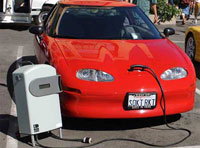Israeli govt pushes drivers toward electric cars
The Israeli government announced a major initiative to push the nation's drivers toward electric cars on Monday, a move meant to both lessen dependence on foreign oil and address the environmental and health hazards of gas-burning vehicles.

It is not the first time a government has tried to promote electric cars on a mass scale, Time reports.
The electric car, or simply electric vehicle, is a battery electric vehicle that utilizes chemical energy stored in rechargeable battery packs. Electric vehicles use electric motors and motor controllers instead of internal combustion engines. Vehicles using both electric motors and ICEs are examples of hybrid vehicles, and are not considered pure BEVs because they operate in a charge-sustaining mode.
Hybrid vehicles with batteries that can be charged externally to displace some or all of their ICE power and gasoline fuel are called plug-in hybrid electric vehicles (PHEV), and are pure BEVs during their charge-depleting mode. BEVs are usually automobiles, light trucks, neighborhood electric vehicles, motorcycles, motorized bicycles, electric scooters, golf carts, milk floats, forklifts and similar vehicles.
As of July, 2006, there were between 60,000 and 76,000 low-speed, battery powered vehicles in use in the US, up from about 56,000 in 2004, according to Electric Drive Transportation Association estimates.
The Tesla Roadster, the first 500 of which are scheduled for delivery in early 2008 uses Li-Ion batteries to achieve 245 miles per charge, while also capable of going 0-60 in under 4 seconds.
Subscribe to Pravda.Ru Telegram channel, Facebook, RSS!





